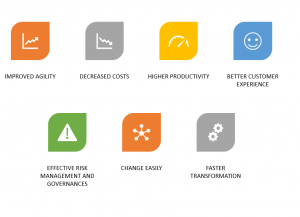What does Low-Code mean?
Low-Code automation platform is a software development technique that require minimal to no coding knowledge to allow the user to automate processes in the application. Instead of using boundless coding language, Low-Code platforms use visual interfaces with simple logic and drag and drop features so that users can make use of them easily and quickly. But when performing complex or specific interactions, coding knowledge is necessary. These platforms reduce the amount of traditional hand coding and so increase business productivity as a result.
Low Code Features
 Low-Code Automation Tools
Low-Code Automation Tools
Creatio:
Creatio is a low-code CRM and Process Automation platform. It offers a CRM solution for sales, marketing, and service. Studio Creatio will help IT as well as non-IT staff to easily build enterprise-grade apps and processes. It can be deployed in the cloud as well as on-premises.
Appian:
Appian is an intelligent automation platform that help the organizations to build smart applications that will improve the business, customer engagement, and worker efficiency. It will ensure you about the security of your critical applications. The Appian low code development platform is a combination of intelligent automation and low-code development.
KiSSFLOW – BPM & Workflow Software:
KiSSFLOW- BPM & Workflow Software allows the user to create custom Apps and automate business processes. It provides more than 45 pre-installed apps to create the user’s own business applications. It provides the cloud-based solution which can be used by businesses of any size and from any industry.
monday.com:
monday.com provides a low code development platform that will helps the user to digitize processes and workflows. It will increase employees’ productivity and engagement. It helps you with fast building the functionality as per your needs. The user can be able to build any feature or functionality as per your requirement through this tool. The platform will let the user to automate the workflows without coding. It has features of interactive boards and custom forms that will provide business data in a quick and standardize way.
Quixy:
Quixy is a no-code BPM and Application Development Platform. It can be used by the business of any industry to build complex enterprise-grade applications. Quixy has dozens of pre-built solutions for various use cases such as CRM and Project & Task Management. Businesses can automate processes across departments using Quixy. It will help you to build complex custom enterprise software faster and with lower costs.
What does No-Code mean?
No-Code Automation is a new approach by creating automation tests which allows the user to test an application without writing a single piece code or script. The aim is to make the setup so easy to use so that automating a test scenario takes less time and require almost no coding efforts. No-Code platforms feature prebuilt drag and drop activities and tasks that facilitate integration at the business user level.
To get a brief idea on No-Code automation, please have a look at the article here:
What is No-Code Automation? | Brainbox
Difference between Low-Code and No-Code Automation
The main difference between Low-Code and No-Code automation are:
Programming Skills:
As their name suggests, No-Code automation platforms allow the user to test an application with out requiring any coding skills. So, anyone in the organization with a technical background can quickly create business applications. The downside is that if people are developing app without super vision or consideration, the results can lead to security concerns, compliance issues, integration problems, and poorly designed app that at best use more resources than necessary and at worst turn the users away.
On the other hand, Low-Code platforms allow the developers to go under the hood and hard core any part they might see it. They offer the automation faster, but only for the people that have real coding skills. For professional developers, the ability to work faster and more efficiently using a visual-based modeler, while also allowing them to code by hand as needed, means the perpetual backlog of needed applications shrinks, while IT’s business value grows.
Automation Design:
No-Code automation platforms allow the user to dominate the automation process design through simple drag and drop activities. Even though Low-Code platforms perform use a similar deployment model, there is ultimately a greater dependence on code for designing automated process.
Developer Dependency:
No-Code automation platforms allow absolute independence to the user to automate process since the user does not need any technical knowledge to operate the platform. On the other hand, Low-Code platforms give non-technical users to automate processes up to a certain point. Most probably, due to lack of coding skills, they need help to finalize the automation project. A developer or a technical person needs to be at hand to speed up the automation.
Summary:
Technically both Low-Code and No-Code platforms are holding same idea. The main difference between Low-Code and No-Code platforms as implied by their names, is that low-code platforms can still include coding in certain cases whereas no code platforms require absolutely no coding.
Contact us at sales@brainbox.consulting for more information and we would be happy to assist you with testing related services.


